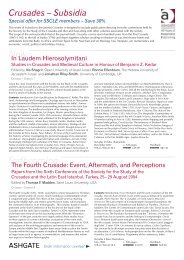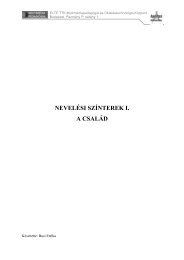Recyclable ligand-free mesoporous heterogeneous Pd catalysts for ...
Recyclable ligand-free mesoporous heterogeneous Pd catalysts for ...
Recyclable ligand-free mesoporous heterogeneous Pd catalysts for ...
Create successful ePaper yourself
Turn your PDF publications into a flip-book with our unique Google optimized e-Paper software.
<strong>Recyclable</strong> <strong>ligand</strong>-<strong>free</strong> <strong>mesoporous</strong> <strong>heterogeneous</strong> <strong>Pd</strong> <strong>catalysts</strong><br />
<strong>for</strong> Heck coupling<br />
Attila Papp, a Gábor Galbács b and Árpád Molnár a, *<br />
a Department of Organic Chemistry, University of Szeged, Dóm tér 8, Szeged H-6720, Hungary<br />
b Department of Inorganic and Analytical Chemistry, University of Szeged, Dóm tér 7, Szeged H-6720, Hungary<br />
Received 4 August 2005; revised 2 September 2005; accepted 7 September 2005<br />
Available online 22 September 2005<br />
Abstract—Ligand-<strong>free</strong> <strong>Pd</strong>–MCM41 <strong>catalysts</strong> are highly active in the Heck coupling of bromoarenes including deactivated bromo<br />
derivatives to give coupled products in high yields with high selectivities without the need to exclude air or moisture. The catalyst<br />
samples exhibit unprecedented stability among <strong>heterogeneous</strong> <strong>catalysts</strong> and can be reused at least 20 times to achieve complete<br />
conversion without any additional activation treatment.<br />
Ó 2005 Elsevier Ltd. All rights reserved.<br />
The Heck reaction 1 is an established, useful protocol <strong>for</strong><br />
carbon–carbon bond <strong>for</strong>mation and has found widespread<br />
applications in the stereoselective synthesis of<br />
various alkenes. Usually aryl halides are reacted with<br />
alkenes in the presence of palladium and a suitable base<br />
in a single step under mild conditions. 2 Ef<strong>for</strong>ts have<br />
recently been made to develop new <strong>catalysts</strong> to replace<br />
air- and moisture-sensitive phosphine <strong>ligand</strong>s, which<br />
also allow the use other aryl derivatives. These new <strong>catalysts</strong><br />
include palladacycles, 3 N-heterocyclic carbene–<br />
palladium <strong>catalysts</strong>, 4 a macrocyclic recoverable triolefin<br />
complex, 5 and thiourea–<strong>Pd</strong>(0) complexes. 6 Attention<br />
has also been paid to the search <strong>for</strong> new, efficient, and<br />
recyclable <strong>heterogeneous</strong> <strong>catalysts</strong>. Among various<br />
strategies, incorporation/grafting of metal complexes<br />
into suitable solids such as polymers 7 or porous siliceous<br />
materials 8 have been demonstrated to be promising approaches.<br />
Equally useful <strong>catalysts</strong> can be prepared by<br />
entrapping 9 or immobilizing 10 metal nanoparticles, and<br />
generating and depositing active metal particles onto<br />
solid supports. 11 In this context, the recent observation<br />
that <strong>Pd</strong>(OAc)2 is a highly active catalyst in the Heck<br />
reaction in low concentrations (catalyst amount below<br />
0.1 mol %) is a significant new development, 12 but further<br />
improvement is needed. Decomposition of the cat-<br />
Keywords: C–C Coupling; Heck reaction; Palladium; MCM-41;<br />
Heterogeneous Catalysis; Recycling.<br />
* Corresponding author. Tel.: +36 62 544 277; fax: +36 62 544 200;<br />
e-mail: amolnar@chem.u-szeged.hu<br />
0040-4039/$ - see front matter Ó 2005 Elsevier Ltd. All rights reserved.<br />
doi:10.1016/j.tetlet.2005.09.048<br />
Tetrahedron Letters 46 (2005) 7725–7728<br />
Tetrahedron<br />
Letters<br />
alytically active component, metal leaching, insufficient<br />
catalyst activity, and difficulties with respect to recovery<br />
and recycling properties are the major problems requiring<br />
significant ef<strong>for</strong>t.<br />
Heterogeneous systems may offer solutions <strong>for</strong> some of<br />
these problems. Ordered <strong>mesoporous</strong> silica materials<br />
prepared by micelle-templated synthesis 13 have recently<br />
found wide application as catalyst materials. Among<br />
various possibilities, surface modification has been used<br />
quite extensively to produce active catalytic materials.<br />
The functional groups of such hybrid organic–inorganic<br />
materials 14 may serve as anchoring sites <strong>for</strong> metal complexes<br />
(heterogenization of homogeneous <strong>catalysts</strong>) 13b,f<br />
or, having suitable catalytic properties, they may act<br />
as surface active sites. 13f,15 Mesoporous silicas may also<br />
serve as supports <strong>for</strong> metal particles. 13a,b,f,15c<br />
Metallic palladium has been incorporated into various<br />
silica materials including amorphous silica 11e,f,16 and<br />
ordered <strong>mesoporous</strong> silicas such as MCM-41, 11a,16,17<br />
HMS, 11c SAB-15, 11c and ETS-10. 11e These <strong>heterogeneous</strong><br />
systems have been used as <strong>catalysts</strong> in hydrogenation<br />
11e,16,17 and in various coupling reactions. 11e,f In<br />
fact, <strong>Pd</strong>–MCM-41 prepared by vacuum deposition has<br />
already been applied in the Heck coupling. 11a<br />
We have found that a new, <strong>heterogeneous</strong> <strong>ligand</strong>-<strong>free</strong><br />
<strong>Pd</strong>–MCM-41 system is an efficient and recyclable catalyst<br />
in the Heck coupling. For our catalyst synthesis<br />
we used a literature method 18 described <strong>for</strong> the synthesis
7726 A. Papp et al. / Tetrahedron Letters 46 (2005) 7725–7728<br />
of MCM-41 and modified it <strong>for</strong> palladium incorporation.<br />
19 Catalysts were generated via simultaneous self<br />
assembling of <strong>mesoporous</strong> MCM-41 silica and particle<br />
generation. Three <strong>catalysts</strong> with palladium loadings of<br />
1.39%, 3.0%, and 5.85% based on inductively coupled<br />
plasma atomic emission spectroscopy (ICP-AES) were<br />
made and characterized by various physical methods.<br />
BET surface areas of the samples calculated by the<br />
BJH method were found to decrease (1099, 979, and<br />
806 m 2 /g, respectively), with increasing palladium loading,<br />
whereas pore diameters and d100 indexed unit-cell<br />
sizes determined by low-angle XRD increase slightly.<br />
The 1.39% <strong>Pd</strong>–MCM-41 sample exhibited three reflections<br />
characteristic of the MCM-41 structure (d100—<br />
2.35°, d110—4.07°, d200—4.6°) but increasing <strong>Pd</strong> loading<br />
resulted in the <strong>for</strong>mation of less ordered structures. <strong>Pd</strong><br />
dispersion values measured by hydrogen chemisorption<br />
were 8.2%, 5.7%, and 13.6%, respectively. Further characterization<br />
data can be found in a recent publication. 20<br />
All three <strong>catalysts</strong> showed high activity and selectivity in<br />
the Heck coupling of iodobenzene with styrene (conversions:<br />
76–84%, selectivities: 84–87%) and methyl acrylate<br />
(89–100% conversions and 100% selectivities)<br />
(Table 1). 21 Moreover, activities in the trans<strong>for</strong>mation<br />
of activated bromoarenes were also satisfactory. In all<br />
reactions complete E selectivity was observed, whereas<br />
in the trans<strong>for</strong>mations of styrene, products of a coupling<br />
were found (Table 1 and Scheme 1). It was also seen that<br />
activities depend on palladium loadings and parallel<br />
metal dispersion: in most cases catalytic per<strong>for</strong>mance<br />
of 3.0% <strong>Pd</strong>–MCM-41 with the lowest <strong>Pd</strong> dispersion<br />
(5.7%) showed lower activity.<br />
In further studies a wide range of other aryl halides were<br />
reacted with styrene and methyl acrylate and appropriately<br />
selected reaction conditions, namely the use of various<br />
bases and additives and the ratio of the reacting<br />
components, were tested. Aromatic chloro compounds<br />
were found not to react but high reactivities could be<br />
achieved with deactivated bromoarenes (4-bromoanisole,<br />
1-bromo-4-chlorobenzene, 1,4-dibromobenzene)<br />
(Table 2). Under these conditions (the use of a small<br />
excess of alkene and Na2CO3 with Bu4NCl as additive),<br />
Table 1. <strong>Pd</strong>-catalyzed Heck reaction over <strong>Pd</strong>–MCM-41 <strong>catalysts</strong> with various <strong>Pd</strong> loadings a<br />
bromobenzene also showed increased reactivity. The<br />
use of Bu4NCl as additive was particularly beneficial<br />
in harmony with earlier observations. 2b,22 Interestingly,<br />
however, both 1-bromo-naphthalene and 3-bromopyridine<br />
gave much better results without the additive.<br />
Aryl halide Alkene 1.39% 3.0% 5.85%<br />
Conversion b<br />
(%)<br />
Selectivity c<br />
(%)<br />
Conversion b<br />
(%)<br />
<strong>Pd</strong>-MCM41<br />
NMP, base, 150 o C<br />
Selectivity c<br />
(%)<br />
yields = 54–100%<br />
selectivites = 71–100%<br />
Conversion b<br />
(%)<br />
Selectivity c<br />
(%)<br />
Iodobenzene Styrene 84 84 76 86 82 87<br />
Me acrylate 100 100 98 100 89 100<br />
4-Iodoanisole Styrene 93 80 83 80 88 80<br />
Me acrylate 100 100 100 100 100 100<br />
4-Bromonitrobenzene Styrene 97 95 100 95 95 95<br />
Me acrylate 100 100 99 100 100 100<br />
4-Bromoacetophenone Styrene 97 93 77 93 89 100<br />
Me acrylate 90 100 91 100 84 92<br />
a<br />
Reaction conditions: equimolar amounts of aryl halide, alkene, and Na2CO3, NMP solvent; time: 1 h <strong>for</strong> iodobenzene, 2 h <strong>for</strong> all other aryl halides.<br />
b<br />
Determined by GC.<br />
c<br />
In all reactions complete E selectivity was observed. In the trans<strong>for</strong>mation of styrene, the product of a coupling was also <strong>for</strong>med.<br />
R 1<br />
+<br />
X<br />
R 2<br />
X=I,Br<br />
R 1 =H,Cl,Br,OMe,Ac,NO2, R 2 C N<br />
= Ph, COOMe<br />
Scheme 1. The Heck reaction.<br />
Table 2. <strong>Pd</strong>-catalyzed Heck reaction of bromoarenes over 1.39% <strong>Pd</strong>–<br />
MCM-41 catalyst a<br />
R 1<br />
Aryl halide Alkene Time<br />
(h)<br />
Conv.<br />
(%)<br />
R 2<br />
Sel. b<br />
(%)<br />
Bromobenzene Me acrylate 3 86 96<br />
Styrene 6 93 93<br />
4-Bromobenzonitrile Me acrylate 3 97 93<br />
Styrene 6 90 95<br />
4-Bromoanisole Me acrylate 3 82 94<br />
Styrene 6 91 89<br />
1,4-Dibromobenzene Me acrylate 3 100 93<br />
Styrene 6 85 92<br />
1-Bromo-4-chlorobenzene Me acrylate 3 64 100<br />
Styrene 6 54 91<br />
1-Bromonaphthalene c<br />
Me acrylate 3 100 100<br />
Styrene 6 100 92<br />
3-Bromopyridine d<br />
Me acrylate 22 94 100<br />
Styrene 22 57 93<br />
a<br />
Reaction conditions: 1 equiv of aryl halide, 1.2 equiv of alkene, and<br />
Na2CO3, 0.2 equiv of Bu4NCl, 0.3 mol % <strong>Pd</strong>.<br />
b<br />
In all reactions complete E selectivity was observed. Side products:<br />
trans<strong>for</strong>mation of styrene—the product of a coupling, trans<strong>for</strong>mation<br />
of methyl acrylate–butyl cinnamate.<br />
c<br />
Without Bu4NCl.<br />
d<br />
Without Bu4NCl, with NaOAc as the base.
Table 3. Recycling of <strong>Pd</strong>–MCM-41 <strong>catalysts</strong> and 10% <strong>Pd</strong>-on-carbon in the Heck coupling of iodobenzene with methyl acrylate a<br />
Entry Catalyst Run 1 Run 3 Run 5 Run 7 Run 8 Run 10 Run 12<br />
1 1.39% <strong>Pd</strong>–MCM-41 85 75 83 53 19 0 0<br />
2 1.39% <strong>Pd</strong>–MCM-41 b<br />
85 97 98 86 34 0 0<br />
3 1.39% <strong>Pd</strong>–MCM-41 c<br />
93 93 93 80 65 44 28<br />
4 3.0% <strong>Pd</strong>–MCM-41 76 77 77 77 54 1 0<br />
5 5.85% <strong>Pd</strong>–MCM-41 80 75 82 79 82 60 20<br />
6 10% <strong>Pd</strong>-on-carbon 87 72 35 0<br />
a<br />
Reaction conditions: equimolar amounts of aryl halide, alkene, and NEt3, 150 °C, 60 min.<br />
b 2<br />
After the first use 10 lL of4· 10 M iodine solution in NMP was added.<br />
c 170 °C, 45 min.<br />
Recovery and catalyst reuse are important issues in the<br />
Heck coupling. Easy catalyst separation and recycling<br />
in successive batch operations can greatly increase<br />
the efficiency of the reaction. Reports exist, which<br />
show some success in this respect using immobilized<br />
complexes 7f,8a–d,g,23 and <strong>heterogeneous</strong> <strong>catalysts</strong> with<br />
metallic <strong>Pd</strong> 9,10,11b,f in a limited number of reuses. We<br />
showed in an earlier study 11h that new <strong>heterogeneous</strong><br />
<strong>Pd</strong> <strong>catalysts</strong> with organic–inorganic hybrid supports<br />
exhibit promising characteristics in recycling studies.<br />
There<strong>for</strong>e, detailed studies were per<strong>for</strong>med with these<br />
new <strong>Pd</strong>–MCM-41 <strong>catalysts</strong> to explore their per<strong>for</strong>mance<br />
in reuse experiments.<br />
First, all three <strong>catalysts</strong> were tested and their per<strong>for</strong>mance<br />
was compared to a commercial sample. Commercial<br />
10% <strong>Pd</strong>-on-carbon rapidly loses activity (Table 3,<br />
entry 6) whereas all <strong>Pd</strong>–MCM-41 samples maintain<br />
activities <strong>for</strong> much longer (entries 1, 4, and 5). Treatment<br />
of 1.39% <strong>Pd</strong>–MCM-41 after the first run with<br />
iodine as described in an earlier study 24 proved to be<br />
useful to increase catalyst activity but was not suitable<br />
to prolong the lifetime of the catalyst (entry 2).<br />
Increased reaction temperature, however, did result in<br />
improvements in both activities and the number of<br />
reuses (entry 3).<br />
In further studies changes in the reactant ratio and a<br />
combination of various bases were tested with 1.39%<br />
and 5.85% <strong>Pd</strong>–MCM-41 <strong>catalysts</strong>, which led to better<br />
per<strong>for</strong>mance. We observed further significant improvements<br />
at increased reaction temperature upon increasing<br />
the amount of both methyl acrylate and base by 50%<br />
(Table 4, entry 1): complete conversion was achieved<br />
and the catalyst could be reused 20 times without any<br />
Table 4. Recycling of 1.39% and 5.85% <strong>Pd</strong>–MCM-41 <strong>catalysts</strong> in the<br />
Heck coupling of iodobenzene with methyl acrylate a<br />
Entry Catalyst Run<br />
1<br />
1 1.39% <strong>Pd</strong>–MCM-41 a<br />
2 1.39% <strong>Pd</strong>–MCM-41 b<br />
3 5.85% <strong>Pd</strong>–MCM-41 b<br />
4 1.39% <strong>Pd</strong>–MCM-41 c<br />
Run<br />
2–5<br />
Run<br />
10<br />
Run<br />
15<br />
Run<br />
20<br />
98 100 100 100 100<br />
100 100 100 100 100<br />
100 100 100 100 100<br />
100 100 100 100 100<br />
a<br />
170 °C, 45 min; methyl acrylate and NEt3: 1.5 equiv each.<br />
b<br />
170 °C, 45 min; 1.5 equiv of methyl acrylate, 1 equiv of NEt3,<br />
0.5 equiv of Na2CO3.<br />
c<br />
150 °C, 60 min; 1.5 equiv of methyl acrylate, 1 equiv of NEt3,<br />
0.5 equiv of Na2CO3.<br />
A. Papp et al. / Tetrahedron Letters 46 (2005) 7725–7728 7727<br />
loss of activity. Similar excellent results were observed<br />
<strong>for</strong> both catalyst samples using a mixture of organic<br />
and inorganic bases (entries 2 and 3). Furthermore, both<br />
the activity and the number of reuses could be maintained<br />
at lower temperature with the mixed bases (entry<br />
4).<br />
In conclusion, we have prepared new <strong>heterogeneous</strong> palladium<br />
<strong>catalysts</strong> supported on <strong>mesoporous</strong> MCM-41<br />
and successfully used them in the Heck coupling of iodoand<br />
bromoarenes. More importantly, the <strong>catalysts</strong> are<br />
stable under the reaction conditions and retain high<br />
activity and selectivity <strong>for</strong> at least to 20 successive runs<br />
without the need to exclude air or moisture. This excellent<br />
catalyst per<strong>for</strong>mance and the easy preparation and<br />
separation of the <strong>catalysts</strong> make these new <strong>Pd</strong>-on-<br />
MCM-41 systems a useful alternative to other <strong>heterogeneous</strong><br />
<strong>Pd</strong> <strong>catalysts</strong>.<br />
Acknowledgment<br />
We thank the Hungarian National Science Foundation<br />
(OTKA grants T042603, TS044690, M041451, and<br />
F043213) <strong>for</strong> financial support.<br />
Supplementary data<br />
Supplementary data associated with this article can be<br />
found, in the online version, at doi:10.1016/j.tetlet.<br />
2005.09.048.<br />
References and notes<br />
1. Heck, R. F. Acc. Chem. Res. 1979, 12, 146–151.<br />
2. (a) Heck, R. F. In Comprehensive Organic Synthesis;<br />
Trost, B. M., Fleming, I., Eds.; Pergamon Press: Ox<strong>for</strong>d,<br />
1991; Vol. 4, p 833; (b) de Meijere, A.; Meyer, F. E.<br />
Angew. Chem., Int. Ed. Engl. 1994, 33, 2379–2411; (c)<br />
Herrmann, W. A. In Applied Homogeneous Catalysis with<br />
Organometallic Compounds; Cornils, B., Herrmann, W.<br />
A., Eds.; VCH: Weinhem, 1996; p 712; (d) Bräse, S.; de<br />
Meijere, S. A. In Metal-Catalyzed Cross-Coupling Reactions;<br />
Diederich, F., Stang, P. J., Eds.; Wiley–VCH:<br />
Weinheim, 1998; Chapter 3, pp 99–166; (e) Beletskaya, I.<br />
P.; Cheprakov, A. V. Chem. Rev. 2000, 100, 3009–3066.<br />
3. (a) Dupont, J.; Pfeffer, M.; Spencer, J. Eur. J. Inorg. Chem.<br />
2001, 1917–1927; (b) Bed<strong>for</strong>d, R. B. Chem. Commun.<br />
2003, 1787–1796.
7728 A. Papp et al. / Tetrahedron Letters 46 (2005) 7725–7728<br />
4. (a) Herrmann, W. A. Angew. Chem., Int. Ed. 2002, 41,<br />
1290–1309; (b) Yong, B. S.; Nolan, S. P. Chemtracts: Org.<br />
Chem. 2003, 16, 205.<br />
5. Masllorens, J.; Moreno-Mañas, M.; Pla-Quintana, A.;<br />
Roglans, A. Org. Lett. 2003, 5, 1559–1562.<br />
6. (a) Dai, M.; Liang, B.; Wang, C.; Chen, J.; Yang, Z. Org.<br />
Lett. 2004, 6, 221–224; (b) Yang, D.; Chen, Y.-C.; Zhu,<br />
N.-Y. Org. Lett. 2004, 6, 1577–1580.<br />
7. (a) DellÕAnna, M. M.; Mastrorilli, P.; Muscio, F.; Nobile,<br />
C. F.; Suranna, G. P. Eur. J. Inorg. Chem. 2002, 1094–<br />
1099; (b) Dahan, A.; Portnoy, M. Org. Lett. 2003, 5,<br />
1197–1200; (c) Datta, A.; Ebert, K.; Plenio, H. Organometallics<br />
2003, 22, 4685–4691; (d) Yang, Y.-C.; Luh, T.-Y.<br />
J. Org. Chem. 2003, 68, 9870–9873; (e) Lin, K.; Song, M.;<br />
Cai, D.; Hao, X.; Wu, Y. Tetrahedron Lett. 2003, 44,<br />
3955–3957; (f) Yamada, Y. M. A.; Takeda, K.; Takahashi,<br />
H.; Ikegami, S. Tetrahedron 2004, 60, 4097–4105.<br />
8. (a) De Vos, D. E.; Dams, M.; Sels, B. F.; Jacobs, P. A.<br />
Chem. Rev. 2002, 102, 3615–3640; (b) Clark, J. H.;<br />
Macquarrie, D. J.; Mubofu, E. B. Green Chem. 2000, 2,<br />
53–55; (c) Zhou, J.; Zhou, R.; Mo, L.; Zhao, S.; Zheng, X.<br />
J. Mol. Catal. A: Chem. 2002, 178, 289–292; (d) Chanthateyanonth,<br />
R.; Alper, H. J. Mol. Catal. A: Chem. 2003,<br />
201, 23–31; (e) Tsai, F.-Y.; Wu, C.-L.; Mou, C.-Y.; Chao,<br />
M.-C.; Lin, H.-P.; Liu, S.-T. Tetrahedron Lett. 2004, 45,<br />
7503–7506; (f) Shimizu, K.; Koizumi, S.; Hatamachi, T.;<br />
Yoshida, H.; Komai, S.; Kodama, T.; Kitayama, Y. J.<br />
Catal. 2004, 228, 141–151; (g) González-Arellano, C.;<br />
Corma, A.; Iglesias, M.; Sánchez, F. Adv. Synth. Catal.<br />
2004, 346, 1758–1764; (h) Yang, H.; Zhang, G.; Hong, X.;<br />
Zhu, Y. J. Mol. Catal. A: Chem. 2004, 210, 143–<br />
148.<br />
9. Kim, N.; Kwon, M. S.; Park, C. M.; Park, J. Tetrahedron<br />
Lett. 2004, 45, 7057–7059.<br />
10. Luo, Ch.; Zhang, Y.; Wang, Y. J. Mol. Catal. A: Chem.<br />
2005, 229, 7–12.<br />
11. MCM-41: (a) Mehnert, C. P.; Weaver, D. W.; Ying, J. Y.<br />
J. Am. Chem. Soc. 1998, 120, 12289–12296; LDH: (b)<br />
Choudary, B. M.; Madhi, S.; Chowdari, N. S.; Kantam,<br />
M. L.; Sreedhar, B. J. Am. Chem. Soc. 2002, 124, 14127–<br />
14136; HMS, SBA15: (c) Yuranov, I.; Moeckli, P.;<br />
Suvorova, E.; Buffat, P.; Kiwi-Minsker, L.; Renken, A.<br />
J. Mol. Catal. A: Chem. 2003, 192, 239–251; <strong>Pd</strong>-SAPO-31:<br />
(d) Srivastava, R.; Venkatathri, N.; Srinivas, D.; Ratnasamy,<br />
P. Tetrahedron Lett. 2003, 44, 3649–3651; ETS-10:<br />
(e) Waghmode, S. B.; Wagholikar, S. G.; Sivasanker, S.<br />
Bull. Chem. Soc. Jpn. 2003, 76, 1989–1992; chitosan: (f)<br />
Caló, V.; Nacci, A.; Monopoli, A.; Fornaro, A.; Sabbatini,<br />
L.; Cioffi, N.; Ditaranto, N. Organometallics 2004, 23,<br />
5154–5158; <strong>Pd</strong>/C: (g) Pröckl, S. S.; Kleist, W.; Gruber, M.<br />
A.; Köhler, K. Angew. Chem., Int. Ed. 2004, 43, 1881–<br />
1882; <strong>Pd</strong>/organically modified silica: (h) Papp, A.; Miklós,<br />
K.; Forgo, P.; Molnár, Á. J. Mol. Catal. A: Chem. 2005,<br />
229, 107–116.<br />
12. (a) de Vries, A. H. M.; Mulders, J. M. C. A.; Mommers,<br />
J. H. M.; Henderickx, H. J. W.; de Vries, J. G. Org. Lett.<br />
2003, 5, 3285–3288; (b) Reetz, M. T.; de Vries, J. G. Chem.<br />
Commun. 2004, 1559–1563.<br />
13. (a) Corma, A. Chem. Rev. 1997, 97, 2373–2420; (b) Ying,<br />
J. Y.; Mehnert, C. P.; Wong, M. S. Angew. Chem., Int. Ed.<br />
1999, 38, 56–77; (c) Ciesla, U.; Schüth, F. Microporous<br />
Mesoporous Mater. 1999, 27, 131–149; (d) Selvam, P.;<br />
Bhatia, S. K.; Sonwane, C. G. Ind. Eng. Chem. Res. 2001,<br />
40, 3237; (e) Valkenberg, M. H.; Hölderich, W. F. Catal.<br />
Rev.-Sci. Eng. 2002, 44, 321–374; (f) Taguchi, A.; Schüth,<br />
F. Microporous Mesoporous Mater. 2005, 77, 1–45.<br />
14. Wight, A. P.; Davis, M. E. Chem. Rev. 2002, 102, 3589–<br />
3614.<br />
15. (a) Thomas, J. M. Angew. Chem., Int. Ed. 1999, 38, 3589–<br />
3628; (b) Anwander, R. Chem. Mater. 2001, 13, 4419–<br />
4438; (c) On, D. T.; Desplantier-Giscard, D.; Danumah,<br />
C.; Kaliaguine, S. Appl. Catal., A 2003, 253, 545–602.<br />
16. (a) Marín-Astorga, N.; Pecchi, G.; Fierro, J. L. G.; Reyes,<br />
P. Catal. Lett. 2003, 91, 115–121; (b) Panpranot, J.;<br />
Pattamakomsan, K.; Goodwin, J. G., Jr.; Praserthdam, P.<br />
Catal. Commun. 2004, 5, 583–590.<br />
17. Selvam, P.; Mohapatra, S. K.; Sonavane, S. U.; Jayaram,<br />
R. V. Appl. Catal. B 2004, 49, 251–255.<br />
18. Grün, M.; Unger, K. K.; Matsumoto, A.; Tsutsumi, K.<br />
Microporous Mesoporous Mater. 1999, 27, 207–216.<br />
19. A synthesis mixture composed of tetraethoxysilane, cetyltrimethylammonium<br />
bromide, NH3, and water in a molar<br />
composition of 1:0.152:2.8:141.2 containing appropriate<br />
amounts of <strong>Pd</strong>Cl2 was used. Details can be found in the<br />
Supporting in<strong>for</strong>mation.<br />
20. Papp, A.; Molnár, Á.; Mastalir, Á. Appl. Catal., A 2005,<br />
289, 256–266.<br />
21. The general procedure <strong>for</strong> the Heck reaction: Reactions<br />
were carried out in a 5 mL glass vial equipped with a<br />
Teflon screw cap. The aryl halide, the alkene, and a base<br />
(triethylamine, NaOAc, Na2CO3, orCs2CO3), 0.33 mmol<br />
of each, and the catalyst (corresponding to 0.3 mol % <strong>Pd</strong><br />
with respect to the aryl halide) were added to the solvent<br />
(N-methyl-2-pyrrolidone, 0.75 mL) and the mixture was<br />
stirred magnetically at 150 °C <strong>for</strong> an appropriate time. No<br />
special precaution was taken to exclude air or moisture.<br />
22. (a) Jeffery, T. Tetrahedron 1996, 52, 10113–10130; (b)<br />
Zapf, A.; Beller, M. Chem. Eur. J. 2001, 7, 2908–2915.<br />
23. (a) Chandrasekhar, V.; Athimoolam, A. Org. Lett. 2002,<br />
4, 2113–2116; (b) Poyatos, M.; Márquez, F.; Peris, E.;<br />
Claver, C.; Fernandez, E. New. J. Chem. 2003, 27, 425–<br />
431; (c) Lin, C.-A.; Luo, F.-T. Tetrahedron Lett. 2003, 44,<br />
7565–7568; (d) Steel, P. G.; Teasdale, C. W. T. Tetrahedron<br />
Lett. 2004, 45, 8977–8980.<br />
24. de Vries, A. H. M.; Parlevliet, F. J.; Schmieder-van de<br />
Vondervoort, L.; Mommers, J. H. M.; Henderickx, H. J.<br />
W.; Walet, M. A. M.; de Vries, J. G. Adv. Synth. Catal.<br />
2002, 344, 996–1002.


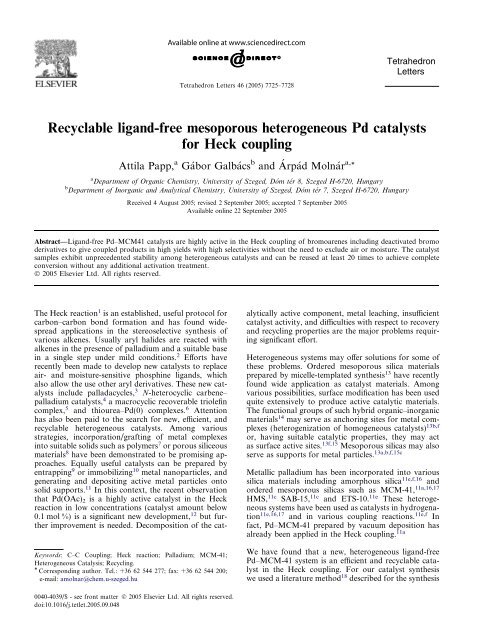
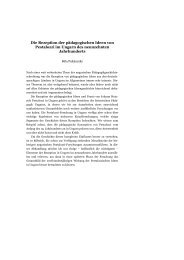
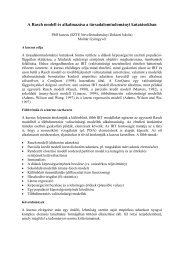
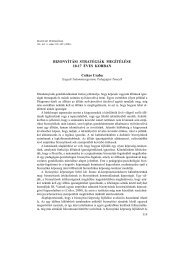

![THE LAWS OF KING STEPHEN I (1000–1038) [BOOK ONE] For ...](https://img.yumpu.com/13124814/1/190x135/the-laws-of-king-stephen-i-1000-1038-book-one-for-.jpg?quality=85)
